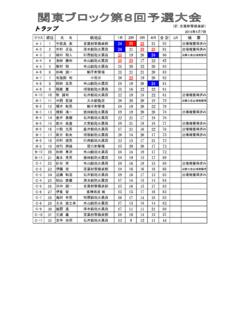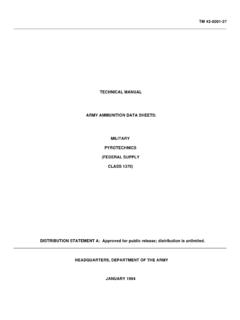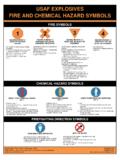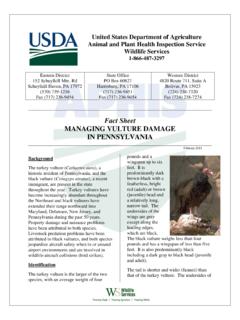Transcription of draft STANAG 4671 - dror-aero.com
1 UAV Systems Airworthiness Requirements (USAR) draft STANAG 4671 - Edition 1 Edition 1 1/205 UAV Systems Airworthiness Requirements (USAR) for North Atlantic Treaty Organization (NATO) Military UAV Systems draft STANAG 4671 Edition 1 March 22nd, 2007 Edition 1 prepared with NATO USAR Specialist Team (2007) UAV Systems Airworthiness Requirements (USAR) draft STANAG 4671 - Edition 1 Edition 1 2/205 This Edition 1 USAR has been the subject of a consultation process with the NATO USAR Specialist Team (2005-2007) including representatives from Canada, France, Germany, Italy, the Netherlands, Spain, Sweden, the United Kingdom, and United States. UAV Systems Airworthiness Requirements (USAR) draft STANAG 4671 - Edition 1 Edition 1 3/205 Introduction GENERAL This document contains a set of technical airworthiness requirements intended primarily for the airworthiness certification of fixed-wing military UAV Systems with a maximum take-off weight between 150 and 20,000 kg that intend to regularly operate in non-segregated airspace.
2 Certifying Authorities may apply these certification requirements outside these limits where appropriate. These requirements represent the minimum applicable requirements to meet the safety objectives defined by paragraph 1309 and its associated AMC. It may be augmented by additional Special Conditions ( additional airworthiness requirements) required by individual Certifying Authorities. USAR is intended for application by Certifying Authorities within each country s relevant national regulatory framework. These requirements may not be sufficient for the certification of UAV Systems with unconventional, novel or extremely complex features. Additionally, USAR may be insufficient for UAV Systems with a design usage spectrum significantly different from that of General Aviation.
3 Nevertheless, the USAR may have significant value for assessing all or parts of such systems and Certifying Authorities are encouraged where appropriate to use these requirements as a basis for certification of such systems within their national regulatory frameworks. UAV Systems (including block upgrades to legacy systems) designed prior to the approval of this document may not comply with these requirements. Appropriate standards and airworthiness certification for these systems for flight in non-segregated airspace, many of which are consistent with this document, are the responsibility of each military Certifying Authority. A glossary is at Annex 1 and a listing of abbreviations used within the document is at Annex 2 to this introduction. Throughout this document, the term Type Certificate refers to any document issued by a National Certifying Authority that within the regulatory framework of that Nation certifies compliance as determined by the National Certifying Authority with USAR.
4 Where the Certifying Authority issues an alternative document to a Type Certificate (such as a Release To Service, Military Aircraft Type Qualification Certificate or Flight Permit, which may include items outside the scope of USAR) it is expected that the degree of compliance with USAR will be clearly stated therein. SCOPE, DERIVATION AND STRUCTURE OF USAR USAR SCOPE The intention of this document is to correspond as closely as practicable to a comparable minimum level of airworthiness for fixed-wing aircraft as embodied in documents such as 14 CFR1 Part 23 and EASA2 CS-23 (from which it is derived) whilst recognising that there are certain unique features of UAV Systems that require particular additional requirements or subparts. 1 Code of Federal Regulations 2 European Aviation Safety Agency UAV Systems Airworthiness Requirements (USAR) draft STANAG 4671 - Edition 1 Edition 1 4/205 In line with the JAA-Eurocontrol Taskforce recommendations, the following areas are not covered by this airworthiness code.
5 Control station security, Security of the command and control data link from willful interference, Airspace integration and segregation of aircraft (including sense and avoid ), The competence, training and licensing of UAV System crew, maintenance and other staff, Approval of operating, maintenance and design organizations, The type of operation, Vehicle Management and Navigation requirements, Frequency spectrum allocation, Noise, emission, and other environmental certification, Launch/landing equipment that is not safety critical and which does not form part of the Type Certification Basis, Operation of the payload (other than its potential to hazard the aircraft), Carriage and release of weapons, pyrotechnics and other functioning or non-functioning stores designed for release during normal operations, Non-deterministic flight, in the sense that UAV flight profiles are not pre-determined or UAV actions are not predictable to the UAV crew, Sea-basing, Piloting from an external or internal control box, Supersonic flight.
6 It is expected that these areas will be subject to other forms of approval by Certifying Authority in order to ensure a total aviation safety approach. Where such approval requires technical assessment, the Certifying Authority may supplement these requirements with suitable additional conditions as appropriate. It is recognized that sense and avoid is a key enabling issue for UAV operations. The derivation and definition of sense and avoid requirements is primarily an operational issue and hence outside the scope of USAR. However, once these requirements have been clarified, any system designed and installed to achieve these objectives is an item of installed equipment within a UAV System and hence falls under the airworthiness requirements of USAR. DERIVATION OF THE USAR This document is an airworthiness code derived from EASA CS-23 (ex JAR 23) requirements supplemented by elements from the following UAV Systems airworthiness and safety documents.
7 Title Date JAA Eurocontrol UAV Task Force Final Report 05/2004 Airworthiness standard for Unmanned aerial vehicles, RAI-UAV - Ente Nazionale Aviazone Civile (Italy) 1999 Design standards UAV - Civil Aviation Safety Authority (Australia) 05/2000 Design and airworthiness requirements for UAV systems DEF STAN 00-970 Part 9 (UK MOD) 05/2002 UAV Systems Airworthiness Requirements (USAR) draft STANAG 4671 - Edition 1 Edition 1 5/205 USICO (Unmanned Safety Issues for Civil Operations) WP 2400 Certification review item (CRI) stall demonstration 01/2004 Equipment, Systems, and Installations in Part 23 Airplanes FAA. (USA) 03/1999 TSO C23d Minimum Performance Standards for Parachute assemblies and Components, Personnel (USA) 07/1992 Special Conditions ; Ballistic Recovery Systems Cirrus SR-20 Installation 14 CFR Part 23 FAA (USA) 10/1997 USAR STRUCTURE These requirements consist of 9 interrelated subparts, covering the following areas: UAV System UAV Command and control data link Communication system UAV control station Other ancillary elements A General x x x x x B UAV Flight x C UAV Structure x x D UAV Design and Construction x x E UAV Powerplant x F6 Equipment x G Operating limitations and information x x x x x H Command and control data link Communication system x x I UAV control station x Subparts A-G are derived directly from CS-23.
8 While subparts H and I follow the format of CS-23, they are unique to USAR. Paragraph numbers throughout subparts A-G correspond directly to CS-23. Where an entire paragraph is not applicable to a UAV System, it is deleted and annotated not applicable . If a sub-paragraph is not applicable, it is deleted and annotated not applicable . Where a paragraph is applicable or partly applicable but its location within sections A-G of CS-23 is inconsistent with UAV Systems ( the logical location in the context of UAV systems is in section H or I), a cross-reference is included at the original location with the annotation not applicable in this subpart . Where a paragraph is unique to USAR, it is identified as such and its paragraph numbering is marked with the prefix U.
9 A cross-reference table between USAR and CS-23 is available in annex 3. This cross-reference table states all USAR paragraphs that have been inspired or adapted from CS-23 but that, due to the structure of USAR could not be maintained in their original CS-23 numbering/position. Their new numbering/position in USAR is mentioned in the cross-reference table. 6 Note: Paragraph 1309 (in subpart F) and its AMC applies to the entire UAV System and not only with the aerial vehicle. UAV Systems Airworthiness Requirements (USAR) draft STANAG 4671 - Edition 1 Edition 1 6/205 These requirements also include Book 2, consisting of material describing acceptable means of compliance. This feature is similar to FAA or EASA advisory material and allows a full set of UAV System certification documentation to be referenced in a single volume.
10 TYPE CERTIFICATION (OR EQUIVALENT) PROCESS USAR has been created to mirror as closely as possible the structure and content of CS-23. Safety assurance assumes that the requirements are used in a process using the same or broadly equivalent steps to Type Certification of 14 CFR Part23/EASA CS-23 aircraft. Where the procedures used by a Certifying Authority differ substantially from this approach, the Authority is expected to determine that the process used ensures that an equivalent level of safety is achieved. Therefore, it is expected that USAR will normally be used to define the UAV System Type Certification Basis (or equivalent national document) using the applicable paragraphs of the USAR Airworthiness Code (Book 1), completed by the related USAR Acceptable Means of Compliance (Book 2).





